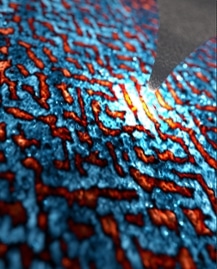Sep 13 2016
 Network of conducting and insulating rivers as seen in a metal-oxide in the middle of a phase transition (picture: A.S. Mueller).
Network of conducting and insulating rivers as seen in a metal-oxide in the middle of a phase transition (picture: A.S. Mueller).
A team of physicists have been successful for the first time in directly visualizing on small scales how a material suddenly alters from conducting state to insulating state at low temperatures.
Erik van Heumen from the University of Amsterdam and Alex McLeod from the University of California have provide confirmation for a 60-year-old theory that explains this occurrence and opens the way for new energy efficient technologies. The team’s experiments are illustrated in the current edition of Nature Physics.
It is a known fact that materials conduct electricity when the temperature is high but are insulating when the temperatures are lower. Until now it has not been possible to directly measure how this sort of phase transitions proceed on small length scales.
Now with their new method, Van Heumen and McLeod are able to visualize the alterations occurring in the material during such a phase transition on the nanometer scale.
Traffic Jams
During their experiments, the team monitored a percolation transition occurring among the electrons in the material. Above a specific critical temperature, the electrons can travel relatively easily via the material enabling the flow of electrical current.
When the temperature falls below a threshold temperature, small defects in the material set off a kind of traffic jam for the electrons. Beginning from small nanometer length scales, this traffic jam gradually increases outwards across the whole material.
The formerly freely moving electrons come to a sudden halt and the conducting properties of the material are lost.
The material that the team used to test the metal-to-insulator transition is the metal-oxide called vanadium-sesquioxide, V2O3, which is more unusual compared to other known metal-oxides such as rust or magnetite. Such metal-oxides are appealing due to their unique electrical properties, which may be used in futuristic electronics applications.
You could use these types of switchable materials alongside the current silicon technology used in cell phones or laptops. These materials are cheap, energy efficient and could contribute to improving sustainability. When used, silicon heats up and becomes disruptive to sensitive quantum technology. The abrupt metal-insulator transition that we investigated could also be forced to take place under influence of, for example, a light flash, which could find applications for better isolating the computational units of quantum computers.
Erik Van Heumen, University of Amsterdam
Lego for Experts
Additional research on the phase transitions in oxides is required before this becomes a reality. Van Heumen: `The fundamental research we are currently doing to better understand the properties of these materials is similar in spirit to research on silicon forty years ago. Nowadays, silicon technology is integrated in all our electronics, so who knows what these materials will be used for twenty years from now.’
Using a clever technique to optimize the resolution of their microscope, Van Heumen and McLeod successfully tested a 60-year old theory that clarifies the change from metal to insulator. Until now, the wavelength of light - with a scale of more than a few micrometers in the case of infrared light - restricted the resolution of electrical conductivity measurements.
The researchers used a small needle to probe the material’s conducting or insulating nature below it with a resolution of 25 nm. The needle itself serves as a tiny antenna that transmits this data back to a detector.
Our technique allows optical imaging at unprecedented spatial resolution. With this unique method, we could directly visualise for the first time how the transition spreads through the material.
Alex McLeod, University of California
The experiment was performed at 100°C below freezing, not quite suitable for real-world applications. However, Van Heumen believes that in the future new materials will be engineered to feature such types of transitions at room temperature.
`Making these materials is like Legos for experts. It is the focus of an intensive research effort that looks very promising.’